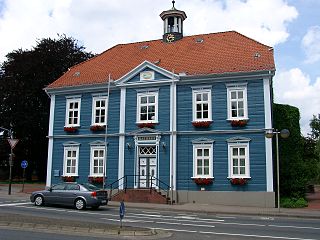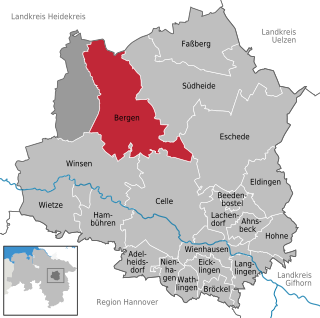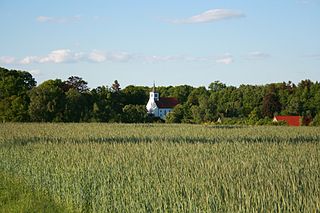
Heidekreis is a district (Landkreis) in Lower Saxony, Germany. It is bounded by the districts of Harburg, Lüneburg, Uelzen, Celle, Hanover, Nienburg, Verden and Rotenburg.

Soltau is a mid-sized town in the Lüneburg Heath in the district of Heidekreis, in Lower Saxony, Germany. It has around 22,000 inhabitants. The city is centrally located in the Lüneburg Heath and is known nationwide especially for its tourist attractions like the Heide-Park and the Soltau-Therme.

Walsrode is a town in the district of Heidekreis, in Lower Saxony, Germany. The former municipality Bomlitz was merged into Walsrode in January 2020.

The Böhme is a right-bank, northeastern tributary of the Aller in the district of Soltau-Fallingbostel in the north German state of Lower Saxony. The river is 72 kilometres (45 mi) long.

Bergen is a town in the north of Celle district on the Lüneburg Heath, in Lower Saxony, Germany. Administratively it acts as a municipal borough divided into 12 subordinate parishes based on the town and its surrounding villages: Becklingen, Belsen, Bergen, Bleckmar, Diesten, Dohnsen, Eversen, Hagen, Hassel, Offen, Sülze and Wardböhmen. Bergen-Belsen concentration camp was located in the area of Belsen.

The Sieben Steinhäuser is a group of five dolmens on the Lüneburg Heath in the NATO training area of Bergen-Hohne, in the state of Lower Saxony in northern Germany. The stones are considered to be part of the funnelbeaker culture. The gravesite was granted protected cultural monument status in 1923.
The Osthannoversche Eisenbahnen AG (OHE) is a Celle based transportation company with railway network in North-eastern Lower Saxony around the Lüneburg Heath area of over 250 km.

Bergen-Hohne Training Area is a NATO military training area in the southern part of the Lüneburg Heath, in the state of Lower Saxony in northern Germany. It covers an area of 284 square kilometres, which makes it the largest military training area in Germany.
The Heidmark is an area of the Lüneburg Heath, much of which has not been accessible to the population since about 1935/1936. The establishment of a large military training area by the German armed forces, the Wehrmacht, as part of their rearmament and preparation for war resulted in the evacuation of 24 villages and, since then the training area has been out-of-bounds to non-military personnel. Today it has become the Bergen-Hohne Training Area, the largest of its kind in Europe.

The Heath Railway is a regional railway line in North Germany that crosses the Lüneburg Heath from which it derives its name. Most of the line is unelectrified and single-tracked. It links Buchholz in der Nordheide with Hanover, the capital city of Lower Saxony. Together with the east-west Uelzen–Langwedel railway, this north-south line is one of the two most important railways on the heath.

Vierde is a village within the borough of Bad Fallingbostel in Soltau-Fallingbostel district in the Heidmark.

The B 440 is a German federal road in Lower Saxony. It runs from the district town of Rotenburg an der Wümme to Bad Fallingbostel. It was based on an old Army road built by Napoléon Bonaparte.

Hans Albert Alexander Louis Carl Stuhlmacher (1892–1962) was a German pedagogue, Wehrmacht officer and local historian.

The village of Dorfmark is part of the borough of Bad Fallingbostel in Heidekreis district in the German state of Lower Saxony.
The Vehmsmoor is a nature reserve in North Germany. It is located in the borough of Walsrode within the district of Soltau-Fallingbostel in Lower Saxony. Its classification number is NSG LÜ 182.

The Bomlitz is a right-bank tributary of the River Böhme in North Germany. It is just under 18 kilometres (11 mi) long and runs through the Heidekreis district in Lower Saxony.
Kroge is a village in the town of Walsrode in North Germany. It lies in the Lower Saxony district of Soltau-Fallingbostel. The village has 290 inhabitants and an area of 7 square kilometres (2.7 sq mi).
Uetzingen is a village in the town of Walsrode in North Germany. It lies in the Lower Saxon district of Heidekreis. The village has 462 inhabitants and its parish covers an area of 10 km².

Bommelsen is a village in the town of Walsrode in North Germany. It lies in the Lower Saxon Heidekreis district. The parish has about 286 inhabitants and an area of 10 km².
Benefeld is part of the municipality of Walsrode in the Lower Saxon Heidekreis district in north Germany. Benefeld has a population of 2,232, although its parish covers just 2 km².

























